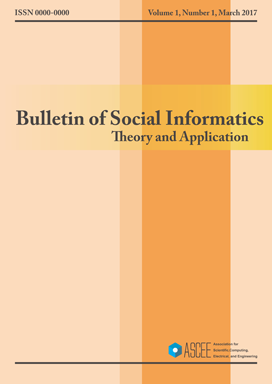Data mining for forecasting community mobility denpasar city with long short-term memory method
DOI:
https://doi.org/10.31763/businta.v8i2.670Keywords:
Data mining, Forecasting , Long short-term memory , Community mobilityAbstract
Denpasar City has a high potential for community mobility, this is supported by many public facilities. High and highly volatile human mobility causes the transmission of the COVID-19 virus to spread very quickly, so forecasting is needed to find out a picture of future community mobility using data mining techniques. Data mining is the process of solving problems by analyzing data that already exists in the database. Denpasar City community mobility data for the period September 1, 2021 – October 31, 2021 show that most of the high mobility is in the junior high school sector. The Long Short-Term Memory method was chosen as a method that can assist in forecasting community mobility. Long Short-Term Memory has the advantage of dealing with missing gradient problems and can be used on all types of data patterns, whether trend, cyclical, seasonal, or horizontal patterns. Hyperparameter tests were carried out including LSTM_units representing the number of Long Short-Term Memory units in each layer, Dropout, and Optimizer to obtain the optimal prediction method. this combination yields a total of 45 methods. The best hyperparameter obtained is at LSTM_units of 128, Dropout of 0.1, and Optimizer is Adam. The results obtained with this hyperparameter are the Root Mean Square Error (RMSE) value of 971,438687. This method results in forecasting the mobility of the people of Denpasar City from November 1, 2021 to November 7, 2021, reaching 9.550 total checkins which is close to the actual value of 10.219
References
WHO, “Coronavirus disease 2019 (COVID-19),†World Health Organization, 2020. [Online]. Available at: https://www.who.int/health-topics/coronavirus#tab=tab_1.
M. U. G. Kraemer et al., “The effect of human mobility and control measures on the COVID-19 epidemic in China,†Science (80-. )., vol. 368, no. 6490, pp. 493–497, May 2020, doi: 10.1126/science.abb4218.
WHO, “WHO, ‘SARS-CoV-2 transmission: implications for infection prevention precautions,’†2020. [Online]. Available at: https://cdn.who.int/media/docs/default-source/searo/indonesia/covid19.
KEMENKES, “COVID-19 Situation by Regency/City,†Kementerian Kesehatan Republik Indonesia, 2021.
S. F. Pane and E. V. Rahcmadani, Big Data : Forecasting Menggunakan Python, 1st ed. Bandung: Kreatif Industri Nusantara, 2020.
A. Bezerra, I. Silva, L. A. Guedes, D. Silva, G. Leitão, and K. Saito, “Extracting value from industrial alarms and events: A data-driven approach based on exploratory data analysis,†Sensors, vol. 19, no. 12, p. 2772, 2019, doi: 10.3390/s19122772.
B. M. Konopka, F. Lwow, M. Owczarz, and Å. ÅaczmaÅ„ski, “Exploratory data analysis of a clinical study group: Development of a procedure for exploring multidimensional data,†PLoS One, vol. 13, no. 8, p. e0201950, 2018, doi: 10.1371/journal.pone.0201950.
C. Deming, S. Dekkati, and H. Desamsetti, “Exploratory Data Analysis and Visualization for Business Analytics,†Asian J. Appl. Sci. Eng., vol. 7, no. 1, pp. 93–100, 2018, doi: 10.18034/ajase.v7i1.53.
K. Chen, X. Jiang, Y. Li, and R. Zhou, “A stochastic agent-based model to evaluate COVID-19 transmission influenced by human mobility,†Nonlinear Dyn., vol. 111, no. 13, pp. 12639–12655, Jul. 2023, doi: 10.1007/s11071-023-08489-5.
Y. Hua, Z. Zhao, R. Li, X. Chen, Z. Liu, and H. Zhang, “Deep learning with long short-term memory for time series prediction,†IEEE Commun. Mag., vol. 57, no. 6, pp. 114–119, 2019, doi: 10.1109/MCOM.2019.1800155.
G. Van Houdt, C. Mosquera, and G. Nápoles, “A review on the long short-term memory model,†Artif. Intell. Rev., vol. 53, no. 8, pp. 5929–5955, Dec. 2020, doi: 10.1007/s10462-020-09838-1.
J. Gonzalez and W. Yu, “Non-linear system modeling using LSTM neural networks,†vol. 51, no. 13, pp. 485–489, 2018, doi: 10.1016/j.ifacol.2018.07.326.
H. Abbasimehr, M. Shabani, and M. Yousefi, “An optimized model using LSTM network for demand forecasting,†Comput. Ind. Eng., vol. 143, no. July 2019, p. 106435, 2020, doi: 10.1016/j.cie.2020.106435.
S. Wang, J. Zhao, C. Shao, C. D. Dong, and C. Yin, “Truck Traffic Flow Prediction Based on LSTM and GRU Methods with Sampled GPS Data,†IEEE Access, vol. 8, pp. 208158–208169, 2020, doi: 10.1109/ACCESS.2020.3038788.
I. H. Witten, E. Frank, M. A. Hall, and C. J. Pal, Data Mining Practical Machine Learning Tools and Techniques, 4th ed. Cambridge: Todd Green, 2017. [Online]. Available at: https://openlibrary.telkomuniversity.ac.id/pustaka/165648/data-mining-practical-machine-learning-tools-and-techniques.html.
M. Alazab, S. Khan, S. S. R. Krishnan, Q.-V. Pham, M. P. K. Reddy, and T. R. Gadekallu, “A multidirectional LSTM model for predicting the stability of a smart grid,†IEEE Access, vol. 8, pp. 85454–85463, 2020, doi: 10.1109/ACCESS.2020.2991067.
K. Gupta, N. Jiwani, and N. Afreen, “Blood pressure detection using CNN-LSTM model,†in 2022 IEEE 11th International Conference on Communication Systems and Network Technologies (CSNT), 2022, pp. 262–366, doi: 10.1109/CSNT54456.2022.9787648.
L. Irawan, F. Fauzi, and D. Andwiyan, “Prediction Of Incoming Orders Using The Long Short-Term Memory Method At Pt. Xyz,†JISA(Jurnal Inform. dan Sains), vol. 4, no. 1, pp. 80–89, Jun. 2021, doi: 10.31326/jisa.v4i1.902.
J. Luo, Z. Zhang, Y. Fu, and F. Rao, “Time series prediction of COVID-19 transmission in America using LSTM and XGBoost algorithms,†Results Phys., vol. 27, p. 104462, 2021, doi: 10.1016/j.rinp.2021.104462.
A. Moghar and M. Hamiche, “Stock Market Prediction Using LSTM Recurrent Neural Network,†Procedia Comput. Sci., vol. 170, pp. 1168–1173, 2020, doi: 10.1016/j.procs.2020.03.049.
R. Saleem and S. Shaukat, “Denormalization To Enhance Effciency In Data Mining,†Int. J. Sci. Eng. Res., vol. 7, no. 9, pp. 1409–1413, 2016, [Online]. Available at: https://www.ijser.org/researchpaper/DENORMALIZATION-TO-ENHANCE-EFFCIENCY-IN-DATA-MINING.pdf.
W. Wang and Y. Lu, “Analysis of the Mean Absolute Error (MAE) and the Root Mean Square Error (RMSE) in Assessing Rounding Model,†IOP Conf. Ser. Mater. Sci. Eng., vol. 324, p. 012049, Mar. 2018, doi: 10.1088/1757-899X/324/1/012049.
V. Plotnikova, M. Dumas, and F. P. Milani, “Applying the CRISP-DM data mining process in the financial services industry: Elicitation of adaptation requirements,†Data Knowl. Eng., vol. 139, p. 102013, 2022, doi: 10.1016/j.datak.2022.102013.
C. Schröer, F. Kruse, and J. M. Gómez, “A Systematic Literature Review on Applying CRISP-DM Process Model,†Procedia Comput. Sci., vol. 181, pp. 526–534, 2021, doi: 10.1016/j.procs.2021.01.199.
S. Al Gharbi, A. Al-Majed, A. Abdulraheem, S. Patil, and S. Elkatatny, “Using data-mining CRISP-DM methodology to predict drilling troubles in real-time,†p. 10, 2021, doi: 10.2118/201026-MS.
F. MartÃnez-Plumed et al., “CRISP-DM twenty years later: From data mining processes to data science trajectories,†IEEE Trans. Knowl. Data Eng., vol. 33, no. 8, pp. 3048–3061, 2019, doi: 10.1109/TKDE.2019.2962680.
S. F. Nissa and A. Haryanto, “Implementation of Face-to-Face Learning During the Covid-19 Pandemic,†J. IKA PGSD (Ikatan Alumni PGSD) UNARS, vol. 8, no. 2, p. 402, 2020, doi: 10.36841/pgsdunars.v8i2.840.
S. Muzaffar and A. Afshari, “Short-term load forecasts using LSTM networks,†Energy Procedia, vol. 158, pp. 2922–2927, 2019, doi: 10.1016/j.egypro.2019.01.952.
R. Y. Hayuningtyas, “Inventory forecasting using the weighted moving average method and the double exponential smoothing method,†J. PILAR Nusa Mandiri, vol. 13, no. 2, pp. 217–222, 2017, [Online]. Available at: https://ejournal.nusamandiri.ac.id/index.php/pilar/article/view/240.
Y. Yu, X. Si, C. Hu, and J. Zhang, “A Review of Recurrent Neural Networks: LSTM Cells and Network Architectures,†Neural Comput., vol. 31, no. 7, pp. 1235–1270, Jul. 2019, doi: 10.1162/neco_a_01199




